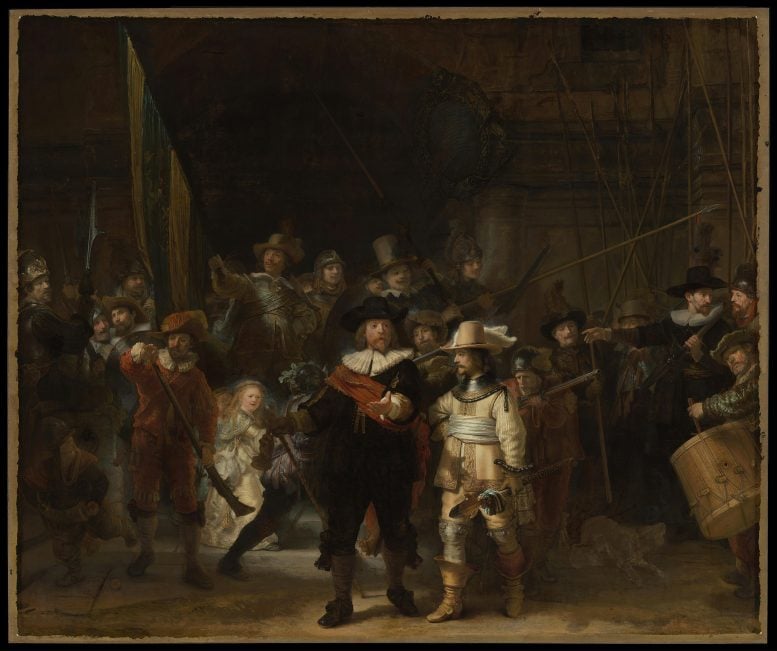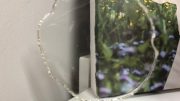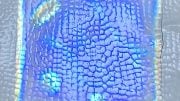
Researchers have unveiled Rembrandt’s technique of using unique arsenic sulfide pigments to produce golden effects in The Night Watch, combining them with other colors to enhance the golden detailing in the artwork. This deliberate pigment choice, backed by historical evidence, highlights his innovative approach to achieving rich, lustrous colors in his masterpieces.
Researchers have discovered that Rembrandt used special arsenic sulfide pigments to create a ‘golden’ paint in “The Night Watch.”
Chemists at the Rijksmuseum and the University of Amsterdam (UvA) have, for the first time, determined how Rembrandt used special arsenic sulfide pigments to create a ‘golden’ paint effect. Utilizing advanced spectroscopic techniques, they mapped the presence of pararealgar (yellow) and semi-amorphous pararealgar (orange/red) pigments in intricate detail in his renowned painting, The Night Watch.
Corroborated by the study of related historical sources, they conclude that Rembrandt intentionally combined these particular arsenic sulfide pigments with other pigments to create the golden luster.
The discovery was published recently in a research paper in the scientific journal Heritage Science, by Fréderique Broers and Nouchka de Keyser, PhD candidates at the UvA’s Van ‘t Hoff Institute for Molecular Sciences and researchers at the Rijksmuseum. They conclude that Rembrandt used the rather unusual combination of pigments to depict the golden threading in the doublet sleeves and embroidered buff coat worn by Lieutenant Willem van Ruytenburch. He is the right of the two central figures at the front of the shooting company tableau, accompanying Captain Frans Banninck Cocq.
Unusual pigments
The discovery of the arsenic sulfide pigments took place in the large-scale research project Operation Night Watch which started in 2019 and continues to deliver striking results. A full X-ray fluorescence (MA-XRF) scan of the painting had already revealed the presence of arsenic and sulfur in parts of Van Ruytenburch’s clothing. It led the researchers to assume the presence of the well-known arsenic sulfide pigments orpiment (yellow) and realgar (red). A detailed study of two tiny paint samples taken from the painting showed otherwise. High-tech analysis combining light microscopy with micro-Raman spectroscopy, electron microscopy, and X-ray powder diffraction revealed the presence of the more unusual arsenic sulfide components pararealgar (yellow) and semi-amorphous pararealgar (orange-red).
Cross section of paint sample SK-C-5_017 as seen through a light microscope. It shows various crystals of yellow, orange, and red pigments of which the precise composition was established using a combination of electron microscopy, Raman spectroscopy, and X-ray powder diffraction. Image courtesy of the Rijksmuseum.
Deliberate use
The presence of pararealgar in historical paintings is often explained by the aging of realgar. However, because pararealgar is homogeneously distributed with the semi-amorphous pararealgar, and the paint looks unaltered, the researchers arrive at a different explanation. They argue that Rembrandt deliberately chose to use these pigments in his effort to imitate the golden details of Van Ruytenburch’s clothing. Heating yellow pararealgar pigment results in the formation of the reddish semi-amorphous pararealgar. This was then combined with lead-tin yellow and vermilion (red mercury sulfide) pigments to create the golden luster.
This chemical explanation was supported by a comprehensive review of historical sources reporting on the use of arsenic sulfide pigments. It seems that in seventeenth-century Amsterdam a broader range of arsenic pigments were available than previously thought. These probably arrived through known trade routes from Germany/Austria and Venice to Amsterdam. This is further supported by the reported use of a very similar mixture of pigments by Willem Kalf (1619–1693), a contemporary of Rembrandt in Amsterdam. The researchers therefore conclude that Rembrandt intentionally used pararealgar and semi-amorphous pararealgar, together with lead-tin yellow and vermilion, to create the special orange-‘golden’ paint.
Reference: “Discovery of pararealgar and semi-amorphous pararealgar in Rembrandt’s The Night Watch: analytical study and historical contextualization” by Nouchka De Keyser, Fréderique T. H. Broers, Frederik Vanmeert, Annelies van Loon, Francesca Gabrieli, Steven De Meyer, Arthur Gestels, Victor Gonzalez, Erma Hermens, Petria Noble, Florian Meirer, Koen Janssens and Katrien Keune, 11 July 2024, Heritage Science.
DOI: 10.1186/s40494-024-01350-x








Be the first to comment on "Unique Pigments Discovered: Chemists Unveil New Secrets of Rembrandt’s Famous Painting “The Night Watch”"